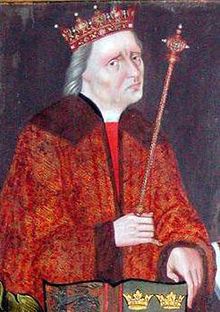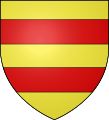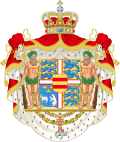- Christian I of Denmark
-
Christian I King of Denmark Reign 28 September 1448 – 21 May 1481 Coronation 2 August 1450, Trondheim Predecessor Christopher of Bavaria Successor John King of Norway Reign 1450 – 21 May 1481 Coronation 2 August 1450, Trondheim Predecessor Charles I Successor John King of Sweden Reign 1457–1464 Predecessor Charles II Successor Charles II Consort Dorothea of Brandenburg Issue John, King of Denmark
Margaret, Queen of Scots
Frederick I, King of DenmarkHouse House of Oldenburg Father Dietrich of Oldenburg Mother Helvig of Schauenburg Born February 1426
OldenburgDied 21 May 1481 (aged 55)
Copenhagen CastleBurial Roskilde Cathedral Religion Roman Catholicism Christian I (February 1426 – 21 May 1481) was a Danish monarch, king of Denmark (1448–1481), Norway (1450–1481) and Sweden (1457–1464), under the Kalmar Union. In Sweden his short tenure as monarch was preceded by regents, Jöns Bengtsson Oxenstierna and Erik Axelsson Tott and succeeded by regent Kettil Karlsson Vasa. Also Duke of Schleswig and Holstein 1460–81.
Contents
Biography
Early years
He was born in February 1426 in Oldenburg. His father was Count Dietrich of Oldenburg (died 1440) whom he succeeded as Count of Oldenburg and Delmenhorst. His mother was his father's second wife, Hedwig of Schleswig and Holstein (Helvig of Schauenburg) (died 1436). Christian had two brothers, Count Moritz V of Delmenhorst (1428–1464) and Count Gerhard VI of Oldenburg and Delmenhorst (1430–1500), and one sister Adelheid.
Christian married Dorothea of Brandenburg (1430 – 25 November 1495), the widow of his predecessor King Christopher (of Bavaria) and thus dowager queen, on 28 October 1449 in Copenhagen.
King Christopher of Denmark, Sweden and Norway died in January 1448. His death resulted in the break-up of the union of the three kingdoms, as Denmark and Sweden went their separate ways. On 1 September 1448, count Christian of Oldenburg was elected to the vacant Danish throne, as king Christian I. He was a cognatic descendant of King Eric V of Denmark through his second daughter Richeza. The throne was first offered by the Statsraad to the most prominent feudal lord of Danish dominions, Duke Adolf VIII of Schleswig-Holstein, but (being relatively old and childless) he declined and recommended his nephew.
King of Sweden and Norway
Meanwhile, Sweden had on 20 June 1448 elected Charles Knutsson as king. Norway was now faced with the choice between a union with Sweden or Denmark, or electing a separate king. The latter option was quickly discarded, and a power-struggle ensued between the supporters of Christian of Denmark and Charles of Sweden. The Norwegian Council of the Realm was divided. In February 1449, a part of the Council declared in favour of Charles as king, but on 15 June the same year, a different group of councellors paid homage to Christian. On 20 November, Charles was crowned king of Norway in Trondheim. However, the Swedish nobility now took steps to avoid war with Denmark. In June 1450, the Swedish Council of the Realm forced Charles to renounce his claim on Norway to king Christian. The question of the Norwegian succession had thereby been decided between Denmark and Sweden, and the Norwegian Council was left with only one candidate for the throne. In the summer of 1450, Christian sailed to Norway with a large fleet, and on 2 August he was crowned king of Norway in Trondheim. On 29 August, a union treaty between Denmark and Norway was signed in Bergen. Norway had of old been a hereditary monarchy, but this had become less and less a reality, as at the last royal successions, hereditary claims had been bypassed for political reasons. It was now explicitly stated that Norway, as well as Denmark, was an elective monarchy. The treaty stipulated that Denmark and Norway should have the same king in perpetuity, and that he would be elected among the legitimate sons of the previous king, if such existed.
Charles Knutsson became increasingly unpopular as king of Sweden, and was driven into exile in 1457. Christian achieved his aim of being elected as king of Sweden, thus re-establishing the Kalmar Union. He received the power from temporary Swedish regents archbishop Jöns Bengtsson Oxenstierna and lord Erik Axelsson Tott. However, Sweden being volatile and split by factions (benefits of union being against nationalistic benefits), his reign there ended in 1464 when bishop Kettil Karlsson Vasa was installed as the next regent. Charles Knutsson was recalled as King of Sweden, although he was later exiled a second time, recalled again and died during his third term as king. Christian's final attempt at regaining Sweden ended in a total military failure at Brunkeberg (outside Stockholm) October 1471 where he was defeated by the Swedish regent Sten Sture the Elder who was supported by the Danish-Swedish nobleman's clan the Thott family. Christian maintained his claim to the Swedish kingdom up to his death in 1481.
Duke and Count
In 1460 King Christian also became Duke of Schleswig, a Danish fief, and Count of Holstein, a Saxe-Lauenburgian subfief within the Holy Roman Empire. Christian inherited Holstein and Schleswig after a short "interregnum" as the eldest son of the sister of late Duke Adolf VIII, Duke of Schleswig (Southern Jutland) and Count of Holstein, of the Schauenburg fürst clan, who died 4 December 1459, without children. There would have been several genealogically senior claimants of Holstein, such as the Counts of Holstein-Pinneberg, but Christian was nephew of the incumbent, the closest relative to that very branch which had lived longest and acquired most fiefs.
Christian's succession was confirmed by the Estates of the Realm (nobility and representatives) of these duchies in Ribe 5 March 1460 (Treaty of Ribe). In 1474 Lauenburg's liege lord Emperor Frederick III elevated Christian I as Count of Holstein to Duke of Holstein, thus becoming an immediate imperial vassal (see imperial immediacy).
Later reign and death
Christian's personal territory was at its largest in 1460–64, before the loss of Sweden. However, many parts of his realm wanted to govern themselves locally, and there were constant struggles. Denmark was his most important center of power. In 1474 Christian travelled two times: in April he went to Milan (his stay in Lombardy is celebrated by frescoes by Il Romanino in the Malpaga Castle) and Rome, in Italy, where he met Pope Sixtus IV. In that occasion, his wife received by the pope the authorization to found a university in Copenaghen, which would be created in 1478 or 1479. In the autumn same year he visited Charles of Burgundy, acting as intermediary between him and emperor Maximilian I. He stayed in Burgundy for several months, moving to the Netherlands in the early 1475.
King Christian died in Copenhagen on 21 May 1481, at the age of 55. He is interred at Roskilde Cathedral.
The dynasty he founded, the House of Oldenburg, has remained on the throne of Denmark,[1] and was on the throne of Norway until 1814 and again from 1905.
Ancestry
Ancestors of Christian I of Denmark 16. John X, Count of Oldenburg 8. Conrad I, Count of Oldenburg 17. Hedwige von Diepholz 4. Christian V, Count of Oldenburg 18. Gerhard IV, Count of Holstein-Itzehoe-Plön 9. Ingeborg of Itzehoe 19. Anastasia von Wittenberg 2. Theodoric, Count of Oldenburg 20. Dietrich III of Honstein 10. Dietrich V or VI, Count of Hohnstein-Heringen 21. Elisabeth of Waldeck 5. Agnes von Hohnstein-Heringen 22. Magnus the Pious, Duke of Brunswick-Lüneburg (=#28) 11. Sophie of Brunswick 23. Sophie of Brandenburg (=#29) 1. Christian I of Denmark 24. Gerhard III of Holstein-Rendsburg, Duke of Schleswig 12. Henry II of Holstein-Rendsburg, Duke of Schleswig 25. Sofie of Mecklenburg-Werle 6. Gerhard VI of Holstein-Rendsburg, Duke of Schleswig 26. Albert II, Duke of Mecklenburg 13. Ingeborg of Mecklenburg 27. Eufemia Ericsdotter of Sweden 3. Helvig of Schauenburg 28. Magnus the Pious, Duke of Brunswick-Lüneburg (=#22) 14. Magnus II, Duke of Brunswick-Lüneburg 29. Sophie of Brandenburg (=#23) 7. Katharina Elisabeth of Brunswick and Lunenburg 30. Bernhard III, Prince of Anhalt-Bernburg 15. Catherine of Anhalt-Bernburg 31. Agnes of Saxe-Wittemberg  Medal of Christian I of Denmark, made during his journey through Italy.
Medal of Christian I of Denmark, made during his journey through Italy.
Issue
Dorothea and Christian had five children:
- Olaf (29 September 1450–1451)
- Knud (1451–1455)
- John (1455–1513), King of Denmark, Norway and Sweden, Duke of Schleswig and Holstein
- Margarete of Denmark (1456–1486), 13 years old married to the 17 years old King James III of Scotland
- Frederick (1471–1533), Duke of Schleswig and Holstein, in Gottorp, later also King of Denmark and Norway
Arms
Christian IBorn: February 1426 Died: 21 May 1481Regnal titles Preceded by
TheodoricCount of Oldenburg
as Christian VI
1440–1448Succeeded by
Gerhard VIPreceded by
Christopher IIIKing of Denmark
1448–1481Succeeded by
JohnPreceded by
Charles IKing of Norway
1450–1481Vacant Regency held by Jon Svaleson SmørTitle next held byJohnVacant Title last held byCharles IIKing of Sweden
1457–1464Vacant Regency held by
Kettil Karlsson (Vasa)Title next held byCharles IIPreceded by
Adolf VIIICount of Holstein
1460–1474Became duke Duke of Schleswig
1460–1481Succeeded by
John I
and
Frederick IBecame duke Duke of Holstein
1474–1481Monarchs of Norway Fairhair dynasty · rival
rulers of other housesHarald I Fairhair · Eric Bloodaxe · Haakon I the Good · Harald II Greycloak · Haakon Sigurdsson 1 · Olaf I Tryggvason · Eiríkr Hákonarson 1 & Sveinn Hákonarson 1 & Hákon Eiríksson 1 · Sweyn Forkbeard · Olaf II the Saint · Hákon Eiríksson 1 · Canute the Great · Sveinn Álfífuson 1 · Magnus I the Good · Harald III Hardrada · Magnus II Haraldsson · Olaf III Kyrre · Haakon Magnusson & Magnus III Barefoot · Olaf Magnusson · Eystein I Magnusson · Sigurd I the Crusader · Magnus IV the Blind · Harald IV Gille · Sigurd the Noisy · Sigurd II Munn · Eystein II Haraldsson · Inge I Haraldsson the Hunchback · Haakon II Broadshoulder · Magnus Erlingsson · Sigurd Markusfostre · Olav the Unlucky · Eystein the Maiden · Sverre Sigurdsson · Jon Kuvlung · Sigurd Magnusson · Inge Magnusson · Haakon III Sverresson · Guttorm Sigurdsson · Inge II Bårdsson · Erling Stonewall · Philip Simonsson · Haakon IV Haakonsson · Haakon the Young · Magnus VI the Law-mender · Eric II Magnusson · Haakon V MagnussonKnýtlinga 985–995
1028–1035Fairhair dynasty · Sweyn Forkbeard 5 · Fairhair dynasty · Canute the Great 5 · Sweyn Knutsson 2 Fairhair dynastyBjelbo 1319–1387The Kalmar union 1387–1448Oldenburg 1448–1814Christian I 4 · John 4 · Christian II 4 · Frederick I 2 · Christian III 2 · Frederick II 2 · Christian IV 2 · Frederick III 2 · Christian V 2 · Frederick IV 2 · Christian VI 2 · Frederick V 2 · Christian VII 2 · Frederick VI 2 · Christian FrederickHolstein-Gottorp
Bernadotte1814–1905Schleswig-Holstein-
Sonderburg-Glücksburgsince 19051 Regent. 2 Also Danish monarch. 3 Also Swedish monarch. 4 Also Danish and Swedish monarch.5 Also Danish and English monarch. Monarchs of Sweden Munsö c.970–c.1060Stenkil c.1060–c.1130
1160–1161Stenkil (Stænkil) · Eric Stenkilsson / Eric the Pagan · Halsten · Anund Gårdske · Håkan the Red · Halsten / Inge the Elder · Blot-Sweyn · Inge the Elder · Philip Halstensson / Inge the Younger · Ragnvald Knaphövde · Magnus the Strong · Houses of Sverker and Eric · Magnus HenriksenSverker · Eric c.1130–1250Sverker the Elder · Eric the Saint · Magnus Henriksen · Charles Sverkersson · Kol / Boleslas · Canute I · Sverker the Younger · Eric Canutesson · John Sverkersson · Eric Ericsson · Canute II 1 · Eric EricssonBjelbo 1250–1364Valdemar Birgersson · Magnus Ladulås · Birger Magnusson · Mats Kettilmundsson 2 · Magnus Ericsson3 · Eric Magnusson · Magnus Ericsson / Haakon Magnusson3Mecklenburg 1364–1389AlbertKalmar Union Italics indicate
regents1389–1523Margaret I of Denmark4 / Eric of Pomerania4 · Engelbrekt Engelbrektsson · Eric of Pomerania4 · Charles Canutesson · Eric of Pomerania4 · Charles Canutesson · Christopher of Bavaria4 · Bengt Jönsson (Oxenstierna) / Nils Jönsson (Oxenstierna) · Charles Canutesson3 · Jöns Bengtsson Oxenstierna / Erik Axelsson Tott · Christian I4 · Kettil Karlsson (Vasa) · Charles Canutesson · Kettil Karlsson (Vasa) · Jöns Bengtsson Oxenstierna · Erik Axelsson Tott · Charles Canutesson · Sten Sture the Elder · John II4 · Sten Sture the Elder · Svante Nilsson · Eric Trolle · Sten Sture the Younger · Christian II4 · Gustaf Eriksson (Vasa)Vasa 1523–1654Palatinate-
Zweibrücken
Hesse-Kassel1654–1751Holstein-Gottorp 1751–1818Bernadotte since 1818Charles XIV John3 · Oscar I3 · Charles XV3 · Oscar II3 · Gustaf V · Gustaf VI Adolf · Carl XVI Gustaf1 Lineage uncertain. 2 Regent. 3 Also Norwegian monarch. 4 Also Norwegian and Danish monarch. 5 Also king of Poland. Notes
- ^ Burke's Royal Families of the World ISBN 0-85011-023-8 p 60
Categories:- Danish monarchs
- Norwegian monarchs
- Swedish monarchs
- Roman Catholic monarchs
- Rulers of Finland
- Kalmar Union
- Dukes of Schleswig
- Dukes of Holstein
- Counts of Holstein
- Counts of Oldenburg
- House of Oldenburg
- 1426 births
- 1481 deaths
- Burials at Roskilde Cathedral
- Swedish monarchs of German descent
- Order of Saint Michael
Wikimedia Foundation. 2010.






